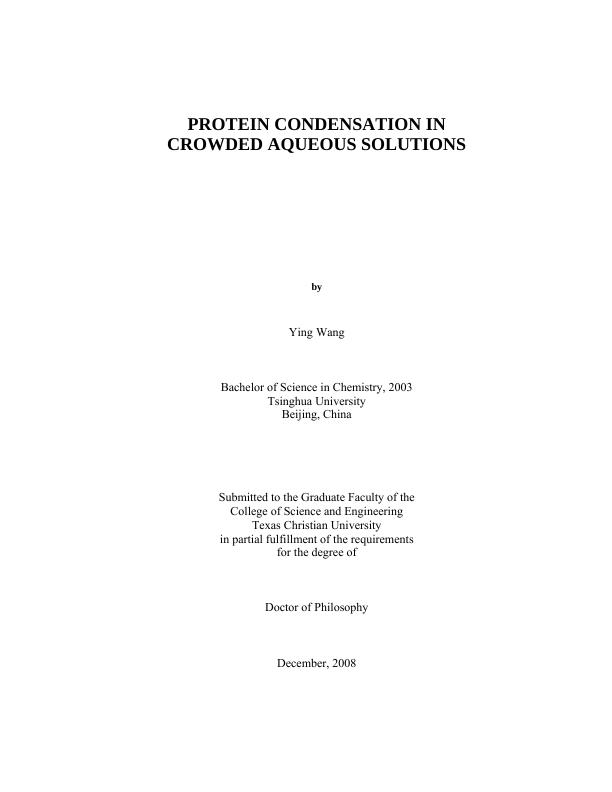Protein condensation in crowded aqueous solutionsShow full item record
| Title | Protein condensation in crowded aqueous solutions |
|---|---|
| Author | Wang, Ying |
| Date | 2008 |
| Genre | Dissertation |
| Degree | Doctor of Philosophy |
| Abstract | The formation of protein condensed phases (e.g., aggregates, gels and crystals) from aqueous solutions is important in materials science, biology, medicine and biotechnology. However this process is not well-understood and physicochemical studies on protein condensation are fundamental for all the above areas. Protein condensation induced in the presence macromolecular additives is known as macromolecular crowding. Although this process is not well-understood, it is believed that the main action of these additives is to enhance protein condensation by depletion interactions related to the size of macromolecules. Polyethylene glycol (PEG), a hydrophilic nonionic polymer, is one of the most widely used macromolecular-crowding agents.^Upon the addition of PEG with an average molecular weight of 1450 g/mol (PEG1450) to bovine serum albumin (BSA) aqueous solutions, protein condensation into oil-like spherical droplets is observed by lowering temperature.^This phenomenon is related to liquid-liquid phase separation (LLPS). To investigate the crowding effect of PEG on protein condensation, two thermodynamically independent properties of the LLPS phase boundary were experimentally characterized: (1) the effect of PEG1450 concentration on the LLPS temperature, (2) BSA/PEG1450 partitioning in the two liquid coexisting phases. A thermodynamic perturbation theory, which includes one parameter describing depletion interactions, was used to examine our experimental results. It was found that both independent properties of the phase boundary could be quantitatively described by the same value of the depletion-interaction parameter.^However, the depletion-interaction parameter determined from our LLPS experiments was found to be significantly different from that theoretically obtained from the molecular size of BSA and PEG1450 by treating PEG as an ideal chain.^The non-ideal behavior of the PEG chain was hypothesized as the main reason for the observed discrepancy. Thus, a more realistic model for the PEG chain was introduced. Monte-Carlo simulations were then performed to calculate novel values of the depletion-interaction parameter from the size of BSA and PEG1450. It is then shown that our new model for PEG chains significantly improves the agreement between experimental results and theory. The role of protein oligomerization on protein condensation was also investigated. It is shown that LLPS of protein aqueous solutions can be isothermally induced by protein oligomerization.^For BSA and lysozyme as protein models, protein oligomerization in the presence of glutaraldehyde as a chemical cross-linker can evolve either towards the formation of cross-linked protein condensed droplets or macroscopic amorphous aggregation, depending on the LLPS properties of the protein monomer.^Finally, laccase condensation from aqueous solutions was investigated. Laccase is an enzyme used in the petroleum, paper and food industry. The thermodynamic behavior of laccase condensation and the morphology of laccase condensed phases was observed to strongly depend on the nature of the additive (PEG or (NH4)2SO4). Interestingly, laccase condensation could be also induced by using liquid-liquid interfaces. At low enzyme concentrations, it is shown that laccase condensation can be driven by BSA-laccase cross-linking and BSA condensation. This has produced catalytically-active aggregates.^The reported preliminary results on laccase provide the basis for more systematic experimental and theoretical investigations on this system. |
| Link | https://repository.tcu.edu/handle/116099117/4112 |
| Department | Chemistry and Biochemistry |
| Advisor | Annunziata, Onofrio |
Files in this item
This item appears in the following Collection(s)
- Doctoral Dissertations [1526]
© TCU Library 2015 | Contact Special Collections |
HTML Sitemap



